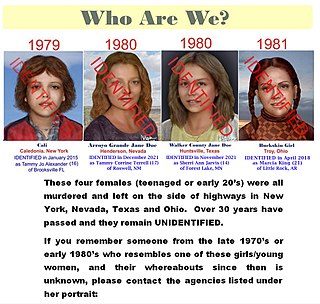
Erica Michelle Marie Green, also known as Precious Doe, was an American three-year-old girl who was murdered in Kansas City, Missouri, in April 2001. Green's decapitated body was discovered on April 28, 2001, and her head was found nearby on May 1, and then remained unidentified until May 5, 2005. Green's murder attracted significant media and public attention due to the brutality of the crime and the lengthy period without identification.

The Sumter County Does, also known as Jock Doe and Jane Doe, were two unidentified homicide victims found in Sumter County, South Carolina, on August 9, 1976. They had apparently traveled through various places in the United States before being killed in South Carolina. This was inferred from some of their belongings.
The Long Island serial killer is an unidentified suspected serial killer who is believed to have murdered 10 to 16 people over a period of nearly 20 years, mostly women associated with prostitution, and left their bodies in areas on the South Shore of Long Island, New York.

Princess Doe is the name given to an unidentified American homicide victim found in Cedar Ridge Cemetery in Blairstown, New Jersey on July 15, 1982. The victim was a young white female between the ages of 15 and 20, although she has also been stated to be as young as 14. Her face had been bludgeoned beyond recognition. The approximate height of the victim was 5 feet 2 inches and her weight was 110 lbs. She was the first unidentified decedent to be entered in the National Crime Information Center.

Lady of the Dunes is the nickname for an unidentified woman discovered on July 26, 1974 in the Race Point Dunes, Provincetown, Massachusetts. Her body was exhumed in 1980, 2000, and 2013 in efforts to identify her and her murderer; to date, these efforts have been unsuccessful. The case was featured on the television series Haunting Evidence in 2006.

Marcia Lenore Sossoman (King) was killed and her body discovered in April 1981 in Miami County, Ohio, near the city of Troy. She is known for being formally identified by county police 37 years after her death, in April 2018, by techniques including DNA analysis and genetic genealogy.

Beth Doe is the name given to an unidentified young European-American woman who was found murdered on December 20, 1976, in White Haven, Pennsylvania. The brutality of the crime, the fact that she was pregnant when she was killed and the length of time that she has remained unidentified created national attention. Beth Doe is believed to have been an immigrant from a Central European country. In 2019, it was announced police were considering the possibility that this victim had been a runaway foster child who was last known to be in New York. Further investigation revealed the girl was still alive.

Walker County Jane Doe is the name given to an unidentified murder victim and victim of an unsolved crime whose body was discovered on November 1, 1980, in Huntsville, Texas. She was aged between 14 and 20 at the time of her death, and her body was discovered within hours of her sexual assault, rape, and murder.

Holly Jo Glynn was a formerly unidentified American woman who is believed to have committed suicide in September 1987 by jumping off a cliff in Dana Point, California. Her body remained unidentified until 2015, when concerns previously expressed by friends of Glynn that the unidentified woman may have been their childhood friend, whom they had been unable to locate for several years, were proven to be true.

Unidentified decedent or unidentified person is a term in American English used to describe a corpse of a person whose identity cannot be established by police and medical examiners. In many cases, it is several years before the identities of some UIDs are found, while in some cases, they are never identified. A UID may remain unidentified due to lack of evidence as well as absence of personal identification such as a driver's license. Where the remains have deteriorated or been mutilated to the point that the body is not easily recognized, a UID's face may be reconstructed to show what they had looked like before death. UIDs are often referred to by the placeholder names "John Doe" or "Jane Doe".
The Redhead Murders refers to a series of unsolved homicides of redheaded women between October 1978 and the 1980s, believed to have been committed by an unidentified male serial killer. The murders believed to be related have occurred in states including Tennessee, Arkansas, Kentucky, Mississippi, Pennsylvania, and West Virginia. The murders may have continued until 1992. The victims, many of whom have never been identified, were usually women with reddish hair, whose bodies were abandoned along major highways in the United States. Officials believe that the women were likely hitchhiking or may have engaged in prostitution.

Michelle Angela Garvey was an American girl murdered in Texas within a month of running away from her home in Connecticut. Her body was quickly found but remained unidentified until a 2014 DNA test, after an amateur Internet researcher suggested a match between the Texas unidentified decedent and Connecticut missing person data.

Brenda Marie Gerow, previously known as Pima County Jane Doe, was a formerly unidentified American murder victim who was found on April 8, 1981. In late 2014, a photograph of a facial reconstruction of the victim was made public that led to Gerow's identification the next year. She had been buried under a headstone with the placeholder name of "Jane Doe" with the phrase "UNK – 1981". Gerow's body remained unidentified for 34 years until it was announced that her remains had positively been identified.

Carol Ann Cole was a seventeen-year-old American murder victim whose corpse was discovered in early 1981 in Bellevue, Bossier Parish, Louisiana. The victim remained unidentified until 2015, when DNA tests confirmed her identity. Cole, native to Kalamazoo, Michigan, had been missing from San Antonio, Texas since 1980. Cole's murder remains unsolved, although the investigation is continuing.



















